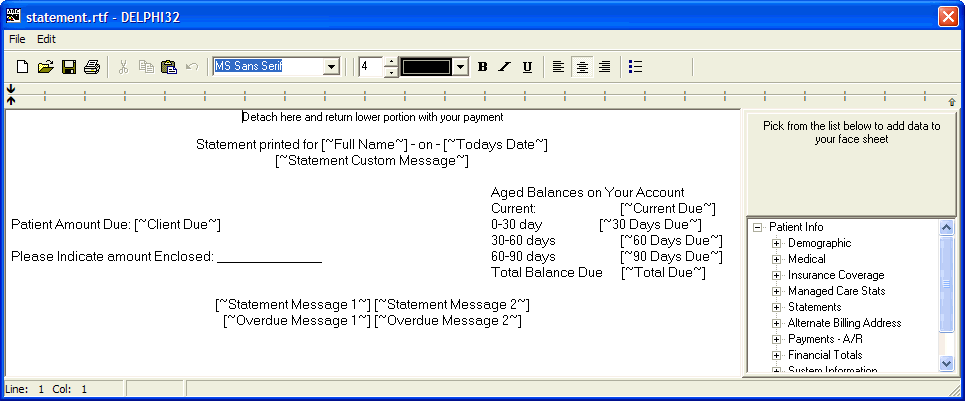
Lower Section
OVERVIEW:
This section provides instructions for customizing the look, feel, and content of the lower section of the client statement.
HOW TO GET THERE:
1) At the Main screen.
2) Select the 'Setup' menu at the top of the screen and scroll down to 'Statement'.
3) The 'Design your own Statement' screen will appear. The image displayed below is the lower section of the statement only. Details on the upper section and middle section can be found in their appropriate sections.
4) You can begin editing the lower section of the statement by simply clicking anywhere on the lower section, or clicking on the button located at the right labeled 'Edit the bottom of the statement.

INSTRUCTIONS:
Once you have clicked on the lower section to 'Edit the bottom of the statement', a screen similar to the one shown below will be displayed.

This is where you edit the statement to meet your particular needs. Editing the default template for the lower section of the statement takes place in the left part of the screen. The powerful part of this feature is contained in the right side of the screen below the section labeled "Pick from the list below to add data to your face sheet". This section allows you to place predefined information about the client into the statement. The section to the right contains a "tree view" that categorizes hundreds of items about a client into a hierarchical selection list.
For example, if you click on the (+) plus sign next to the "Demographic" branch, DELPHI32 will open the demographic branch displaying several dozen items related to the demographic characteristics of the client. Each selectable item has a checkbox next to it. If you were to check the box next to "Sex", DELPHI32 will automatically place the following text on the last line of the existing progress note:
Sex: {~Sex~}
The result of the above text in the lower section of the statement will result in the word "Sex:" followed with the actual gender of the client (which would be either MALE or FEMALE depending on the client the statement is retrieved for). The important point here is that the funny looking brackets surrounding {~Sex~} cause DELPHI32 to lookup the gender of the client and replace the brackets and the instruction contained in it, in this case Sex, with the actual gender of the client. Be sure not to delete those brackets.
Aside from the ability to automatically merge client information into a statement, you have total control over formatting this section of your statement. By simply selecting the text you wish to format, you can change its font, color, size, and positioning. The text formatting tools are located at the top of the screen.
When you've finished editing, simply click the close button (X) in the upper right corner and select 'Yes' if you wish to save any changes you have made.
| Browser Based Help. Published by chm2web software. |